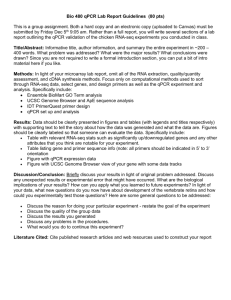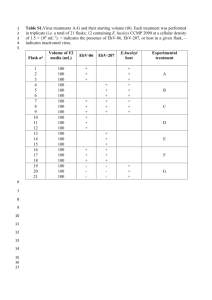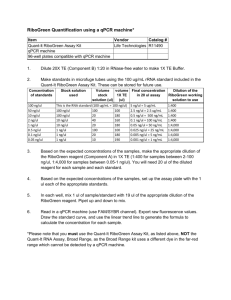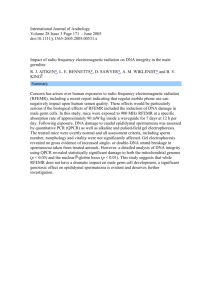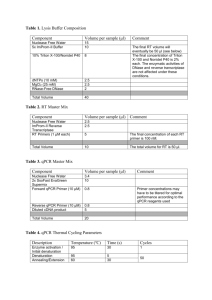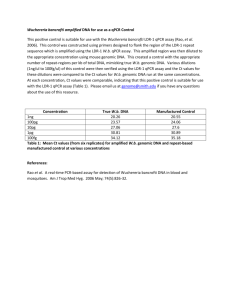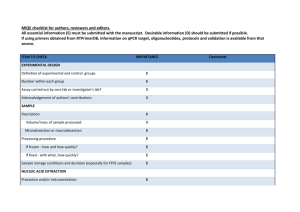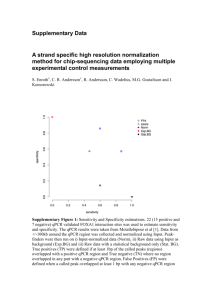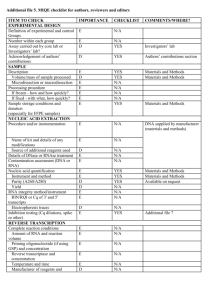Adeno-X™ qPCR Titration Kit User Manual
advertisement
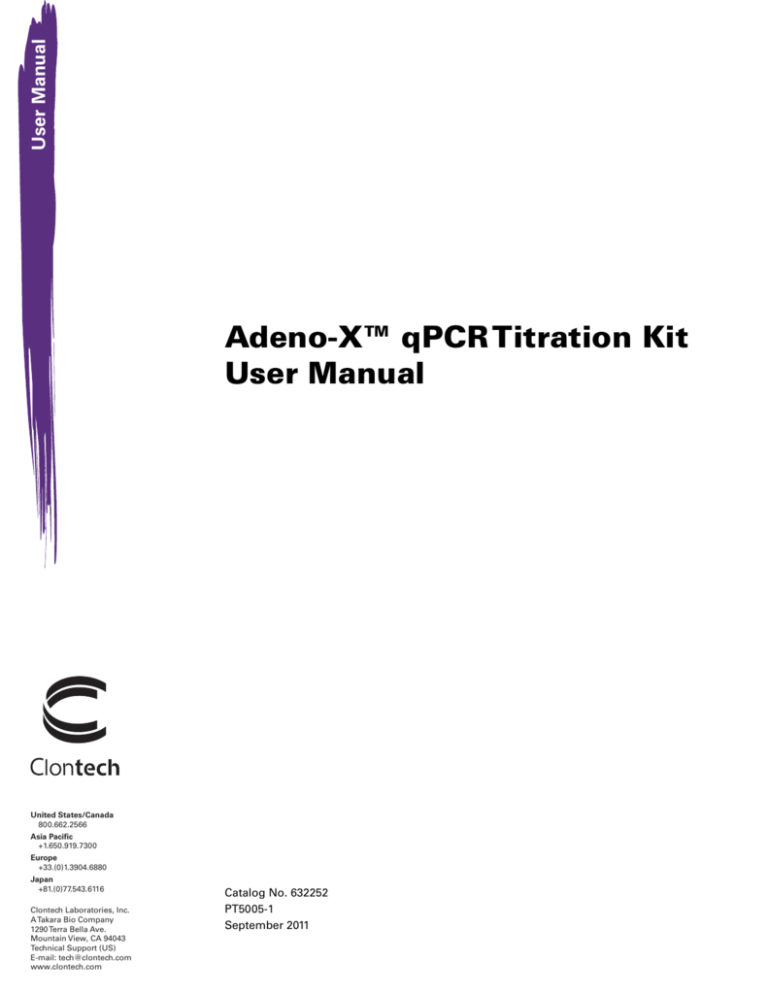
User Manual Adeno-X™ qPCR Titration Kit User Manual United States/Canada 800.662.2566 Asia Pacific +1.650.919.7300 Europe +33.(0)1.3904.6880 Japan +81.(0)77.543.6116 Clontech Laboratories, Inc. A Takara Bio Company 1290 Terra Bella Ave. Mountain View, CA 94043 Technical Support (US) E-mail: tech@clontech.com www.clontech.com Catalog No. 632252 PT5005-1 September 2011 Adeno-X™ qPCR Titration Kit User Manual Table of Contents I. Introduction............................................................................................................................... 3 II. List of Components................................................................................................................... 4 III. Additional Materials Required................................................................................................. 4 IV. Adenoviral Titration Protocols................................................................................................. 5 A.General Recommendations ................................................................................................................. 5 B.Preparation of NucleoSpin® Virus Kit Buffers....................................................................................... 5 C.Protocol: Purifying Adenoviral Genomic DNA................................................................................ 6 D.Protocol: qPCR Amplification of Adenoviral Genomic DNA.......................................................... 7 E. Data Analysis..................................................................................................................................... 10 V. Troubleshooting...................................................................................................................... 11 List of Figures Figure 1. Flowchart of the proceedure for titrating adenovirus with the Adeno-X qPCR Titration Kit........ 3 Figure 2. Using the Adeno-X DNA Control Template to generate a standard curve................................. 10 List of Tables Table I: DNase I Reaction..................................................................................................................... 6 Table II: Master Reaction Mixes Recommended for Different qPCR Instruments.................................. 7 Table III: Control and Sample Dilutions for qPCR.................................................................................. 8 Table IV: Recommended Thermal Cycling Conditions for Different qPCR Instruments.......................... 9 Table V: Adeno-X qPCR Titration—Correlation of Viral Titer and Infectivity for Crude Lysates and Purified Viral Particles . ....................................................................................................................... 11 Table VI. Troubleshooting Guide for Adeno-X qPCR Titration............................................................. 11 Contact Us For Assistance Customer Service/Ordering: Technical Support: Telephone: 800.662.2566 (toll-free) Telephone: 800.662.2566 (toll-free) Fax: 800.424.1350 (toll-free) Fax: 650.424.1064 Web: www.clontech.com Web: www.clontech.com E-mail: orders@clontech.com E-mail: tech@clontech.com Protocol No. PT5005-1 www.clontech.com Version No. 092111 2 Clontech Laboratories, Inc. A Takara Bio Company Adeno-X™ qPCR Titration Kit User Manual I. Introduction A. Summary The Adeno-X qPCR Titration Kit provides a fast and simple method for titrating adenoviral stocks (Clontechniques, April 2009). The kit employs a quick DNA purification step and determines viral DNA genome content using qPCR and SYBR® Green chemistry. Titration can be completed in only 4 hours and is designed for use with all Ad5-based vectors, including recombinant adenovirus created with our Adeno-X Expression Systems. Using this kit reduces time delays between virus harvest and target cell infection, allowing you to do both on the same day. B. Protocol Overview Adenovirus can be quantitated from either crude adenoviral lysate or purified viral particles. First, a small aliquot of lysate or purified virus is treated with DNase I to remove any residual host cell DNA or plasmid DNA that may have been carried over from the packaging cells. The prep is then treated with Proteinase K to remove the DNase I and open up the viral particle, and the included viral DNA purification kit is used to purify the viral genomic DNA. Next, serial dilutions of the viral DNA sample are subjected to qPCR to determine the threshold cycle (Ct) for each dilution. The DNA copy number in a diluted sample is then determined from a standard curve generated by plotting the Ct values of the diluted Adeno-X DNA Control Template against their respective copy numbers. Obtain adenoviral lysate Purify viral DNA qPCR Figure 1. Flowchart of the proceedure for titrating adenovirus with the Adeno-X qPCR Titration Kit C. Correlating Viral Titer with Infectivity Once the genome copy number of your viral stock is determined, it can be correlated with the number of viral infec tious units (IFU; determined independently) to establish an infectivity coefficient (copy number/IFU; see Table V, pg. 11). Determination of the infectivity coefficient for a given prep allows you to normalize the amount of prep used in each experiment, for consistent interassay results. Representative infectivity coefficients (determined with different infectivity titration methods) for a typical Adeno-X virus are shown in Table V. These values should be consistent for similarly prepared viral stocks. However, the calculated ratio may vary due to differences in the amount of virus obtained from individual adenoviral amplifications. Variations in the amount of virus amplified can be caused by differences in cell number, innoculum amount, or time elapsed before the cytopathic effect is observed; therefore, a standardized amplification procedure should be used to help ensure consistent results. Clontech Laboratories, Inc. www.clontech.com A Takara Bio Company Protocol No. PT5005–1 Version No. 092111 3 Adeno-X™ qPCR Titration Kit User Manual II. List of Components Store the Adeno-X qPCR Titration Kit Components at –20°C. Store the SYBR® Advantage® qPCR Premix and ROX Reference Dyes (Cat. No. 636976) at –70°C in the dark. After thawing, store at 4°C in the dark. Do not refreeze. Store the NucleoSpin Virus Kit at room temperature. Adeno-X qPCR Titration Kit (200 rxns; Cat. No. 632252) Adeno-X qPCR Titration Kit components (not sold separately) 30 µl Adeno-X DNA Control Template (5 x 108 copies/µl) • • 100 µl Adeno-X Forward Titer Primer (10 µM) • 100 µl Adeno-X Reverse Titer Primer (10 µM) • 50 µl DNase I (5 units/µl) • 4 tubes EASY Dilution Buffer (1 ml per tube) SYBR Advantage qPCR Premix (200 rxns; Cat. No. 639676) • 4 tubes 2X SYBR Advantage qPCR Premix (0.625 ml per tube) • 100 µl 50X ROX Reference Dye LSR • 100 µl 50X ROX Reference Dye LMP NucleoSpin Virus Kit (10 preps; Cat. No. 740977.10) III. • 10 ml Lysis Buffer RAV1 • 6 ml Wash Buffer RAW • 12.5 ml Wash Buffer RAV3(Concentrate) • 5 ml RNase-free H2O • 5 ml Elution Buffer RE (5 mM Tris/HCl, pH 8.5) • 300 μg Carrier RNA (lyophilized) • • 0.8 ml Proteinase Buffer PB • 10 NucleoSpin Virus Columns (dark blue rings, plus Collection Tubes) • 30 Collection Tubes (2 ml) 6 mg Proteinase K (lyophilized) Additional Materials Required • Work areas and pipettors free of contaminating DNA and DNases. • Quantitative real-time PCR thermal cycler (e.g., Mx3000P, Stratagene; ABI 7900, Applied Biosystems; or equivalent) • Ethanol • PCR-grade water • 96-well PCR plates and 8-well PCR strips • Repeating pipettor with 23 µl capacity (Section IV.C) • Multichannel pipettor(s) with 2–25 µl capacity Protocol No. PT5005-1 www.clontech.com Version No. 092111 4 Clontech Laboratories, Inc. A Takara Bio Company Adeno-X™ qPCR Titration Kit User Manual IV. Adenoviral Titration Protocols Please read these protocols in their entirety before starting Successful titration results depend on performing the following steps in sequence. A. General Recommendations Due to the tremendous amplification power and sensitivity of qPCR, even trace amounts of contaminating DNA will be amplified and will affect Ct and final copy number values. Before you begin, prepare work areas free of potentially contaminating DNA and DNases. If possible, dilute your samples and controls in one work area with a dedicated set of pipettors, and assemble your qPCR reactions in a separate area or noncirculating containment hood, using a different set of dedicated pipettors. Wear gloves at all times and use PCR pipette tips with hydrophobic filters, and dedicated solutions. We also recommend setting up negative template control (NTC) reactions lacking any template. Finally, perform all post-PCR analyses in a separate area, preferably in a separate room, with different pipettors. B. Preparation of NucleoSpin Virus Kit Buffers Important: RAV1 and RAW Buffers contain guanidine salts! Wear gloves and goggles! Attention • Storage: All kit components can be stored at room temperature (20–25°C) and are stable for up to one year. • Proteinase K: Before using the kit for the first time, add 260 µl Proteinase Buffer to dissolve the lyophilized Proteinase K. Proteinase K solution is stable at –20°C for 6 months. • RAV1 Buffer: 1. Before using the kit for the first time, add 1 ml RAV1 Buffer to the vial containing Carrier RNA. Dissolve the RNA and transfer it back to the RAV1 bottle. Attention 2. Carrier RNA has a limited shelf life in RAV1 Buffer. RAV1 Buffer containing Carrier RNA: a.Can be stored at room temperature for 1–2 weeks. Room temperature storage prevents salt precipitation. b.Can be stored at 4°C for up to 4 weeks or aliquoted and stored at –20°C for longer periods. Storage at or below 4°C may cause salt precipitation; therefore, to redissolve the salt, the mixture must be preheated at 40–60°C for a maximum of 5 min. Note: Do not warm RAV1 Buffer containing Carrier RNA more than 4 times! Frequent warming, temperatures > 80°C, and extended heat incubation will accelerate the degradation of Carrier RNA. This leads to reduced recovery of viral DNA and eventually false negative qPCR results, particularly if low-titer samples are used. • RAV3 Buffer: Add 50 ml ethanol (96–100%) to the bottle of RAV3 Buffer. Mark the label of the bottle to indicate that the ethanol has been added. Store the RAV3 Buffer at room temperature (20–25°C) for up to one year. Clontech Laboratories, Inc. www.clontech.com A Takara Bio Company Protocol No. PT5005–1 Version No. 092111 5 Adeno-X™ qPCR Titration Kit User Manual IV. Adenoviral Titration Protocols continued C. Protocol: Purifying Adenoviral Genomic DNA Protocol 1 hr 1. Treat 150 µl of crude, clarified lysate or purified adenoviral particles with DNase I as indicated in Table I. Smaller volumes (50–100 µl) of sample can be used; however, it is necessary to bring the volume up to 150 µl with medium or PBS. Table I: DNase I Reaction Reagent Volume (µl) Adenoviral Sample 150.0 DNase I (5 units/µl) 5.0 Total 155.0 Combine the reagents, mix, and incubate in a thermal cycler or heat block at 37°C for 30 min. 2. Add 600 µl RAV1 Buffer (containing Carrier RNA) and 20 µl Proteinase K (20 mg/ml) to the DNase I-treated sample. Pipette up and down, then vortex for 10–15 sec and incubate the sample at 70oC for 5 min. 3. If the resulting solution is still turbid, centrifuge the mixture for 1 min at 11,000 x g and collect the supernatant in a sterile centrifuge tube. 4. Add 600 μl ethanol (96–100%) to the Proteinase K-treated sample and mix by vortexing (10–15 sec). 5. For each sample, place one NucleoSpin Virus column in a 2 ml collection tube and load 700 μl of the sample. Centrifuge for 1 min at 8,000 x g. Note: When preparing infectious material, use new collection tubes for every step. This decreases the chance of cross-contamination and contamination of the centrifuge. For non-infectious samples, discard the flow-through and reuse the collection tube for loading and washing steps. 6. Load the remaining sample onto the NucleoSpin column. Centrifuge for 1 min at 8,000 x g. Discard the flow-through and put the NucleoSpin column into a new collection tube. More than two loading steps are not recommended. 7. Wash and dry the silica membrane as follows: a. Add 500 μl RAW Buffer to the NucleoSpin column. Centrifuge for 1 min at 8,000 x g, and discard the flow-through. b. Add 600 μl RAV3 Buffer to the NucleoSpin column. Centrifuge for 1 min at 8,000 x g, and discard the flow-through and the collection tube. c. Place the NucleoSpin column in a new collection tube and add 200 μl RAV3. Buffer. Centrifuge for 2–5 min at 11,000 x g. 8. To elute the DNA, place the NucleoSpin column into a sterile, new 1.5 ml microcentrifuge tube. Add 50 µl sterile H2O or RE buffer (preheated to 70oC) and incubate for 1–2 min. Centrifuge for 1 min at 11,000 x g. 9. Store the DNA on ice until you’re ready to perform qPCR (Section C). Protocol No. PT5005-1 www.clontech.com Version No. 092111 6 Clontech Laboratories, Inc. A Takara Bio Company Adeno-X™ qPCR Titration Kit User Manual IV. Adenoviral Titration Protocols continued D. Protocol: qPCR Amplification of Adenoviral Genomic DNA 1. In your reaction assembly work area, make a Master Reaction Mix (MRM) on ice consisting of the reagents in Table II. Make sufficient MRM for the required number of wells. Each control, no-template control (NTC), and sample reaction should be performed in duplicate: Table II: Master Reaction Mixes Recommended for Different qPCR Instruments qPCR Instrument Stratagene Mx3000P Takara Bio Thermal Cycler Dice Real Time System Applied Biosystems Instruments Roche LightCycler Reagent volume (µl per well) for each instrument Reagent PCR-grade H2O 9.0 9.5 6.8 7.2 Adeno-X Forward Primer (10 µM) 0.5 0.5 0.4 0.4 Adeno-X Reverse Primer (10 µM) 0.5 0.5 0.4 0.4 ROX™ Reference Dye LSR or LMP (50X)* 0.5 SYBR® Advantage qPCR Premix (2X) 12.5 12.5 10.0 10.0 23.0 23.0 18.0 18.0 Total volume per well 0.4 *The Kit is supplied with two different ROX formulations that allow you to normalize fluorescence signals on instruments that are equipped with this option. ROX Reference Dye LSR is for instruments whose excitation source is a 488 nm laser, while ROX Reference Dye LMP is for instruments whose excitation source is either a lamp or an LED. Be certain to use the formulation that is appropriate for your real-time instrument! NOTE: To ensure sufficient volume, prepare approximately 10% more Master Reaction Mix than you think you’ll need (see example, below). EXAMPLE CALCULATION: Calculating Total Master Reaction Mix (MRM) Volume: Total MRM Volume = 1.10 x [total number of wells] x [total volume per well] 1. Controls: 5 dilutions in duplicate; 1.10 x 10 wells x 23 µl = 253 µl 2. NTCs: 3 each in duplicate; 1.10 x 6 wells x 23 µl = 152 µl 3. Samples: 4 dilutions in duplicate in duplicate; 1.10 x 8 wells x 23 µl = 202 µl Clontech Laboratories, Inc. www.clontech.com A Takara Bio Company Protocol No. PT5005–1 Version No. 092111 7 Adeno-X™ qPCR Titration Kit User Manual IV. Adenoviral Titration Protocols continued D. Protocol: qPCR Amplification of Adenoviral Genomic DNA continued 2. In your sample dilution work area, and using PCR grade 8-well strips, dilute the Adeno-X DNA Control Template and purified sample(s) with EASY Dilution Buffer as shown in Table III. Table III: Control and Sample Dilutions for qPCR Well Strips 1 & 2: Controls* Strip 3, etc.: Samples 1 5 x 107 Sample 1 (1x) 2 5 x 106 0.1x 3 5 x 10 4 5 x 104 0.001x 5 5 x 103 Sample 2 (1x) 6 NTC 0.1x 7 NTC 0.01x 8 NTC 0.001x 5 0.01x *copies/µl a. Dilute the Adeno-X DNA Control Template in an 8-well strip (Table III, ‘Strip 1’) as follows: i. In the first well, pipet 2 µl of the Adeno-X DNA Control Template stock (5 x 108 copies/µl) into 18 µl of buffer for a 1:10 dilution (diluted sample = 5 x 107 copies/µl). ii. Subsequent dilutions (wells 2–5) can be made by serially transferring 3 µl of the preceding dilution into 27 µl of buffer in the next well. b. Make a duplicate series of dilutions in a second 8-well strip (Table III, ‘Strip 2’). c. Pipet only EASY Dilution Buffer into the last 3 wells of both strips for NTC controls. d. Dilute your DNA sample(s) in another set of 8-well strips; each strip can be used to dilute either 2 duplicate samples or 2 different samples (Table III, ‘Strip 3, etc.’). We recommend making duplicate dilutions of all samples. i. The first well in each series (wells 1 & 5) should contain 20 µl of undiluted sample (1X). ii. Subsequent 10-fold sample dilutions (wells 2–4 & 6–8) can be made by serially transferring 3 µl of sample from one well into 27 µl of buffer in the next well. e. Centrifuge the strips at 2000 rpm (4°C) for 1 min to remove any bubbles. Protocol No. PT5005-1 www.clontech.com Version No. 092111 8 Clontech Laboratories, Inc. A Takara Bio Company Adeno-X™ qPCR Titration Kit User Manual IV. Adenoviral Titration Protocols continued D. Protocol: qPCR Amplification of Adenoviral Genomic DNA continued 3. In your qPCR reaction assembly area, place a 96-well PCR plate on ice (or on a blueblock; 4°C), and dispense the appropriate total volume of MRM/well for your thermal cycler (e.g., 23 µl/well for Stratagene’s Mx3000P, see Table II) into the appropriate wells (in duplicate) using a repeating pipettor. 4. Using a multichannel pipettor, transfer 2 µl/well of the control dilutions, NTCs, and sample dilutions (in duplicate) from the 8-well PCR strips to the PCR plate containing MRM. 5. We recommend that you program your real-time qPCR instrument for the following qPCR reaction cycles (see Table IV). Include a final dissociation curve cycle. Table IV: Recommended Thermal Cycling Conditions for Different qPCR Instruments qPCR Instrument Stratagene Mx3000P Takara Bio Thermal Cycler Dice Real Time System ABI7500 Fast Roche LightCycler ABI7000 Thermal cycling conditions for each instrument Reaction Cycles Initial Denaturation (1 Cycle): 95°C 10 sec 95°C 30 sec 95°C 30 sec 95°C 30 sec 95°C 20 sec qPCR (40 Cycles): 95°C 60°C 5 sec 20 sec 95°C 60°C 5 sec 30 sec 95°C 60°C 3 sec 25 sec 95°C 60°C 3 sec 31 sec 95°C 60°C 5 sec 20 sec Dissociation Curve (1 Cycle): 95°C 55°C 95°C 1 min 30 sec 30 sec 95°C 60°C 95°C 15 sec 30 sec 15 sec 95°C 60°C 95°C 15 sec 1 min 15 sec 95°C 60°C 95°C 15 sec 1 min 15 sec 95°C 60°C 95°C 0 seca 15 sec 0 secb a 20°C/sec 0.1°C/sec b Note: Although Table IV shows the optimized cycling conditions for a selection of commonly used instruments, the Adeno-X qPCR Titration Kit can be used with a variety of real-time instruments and is not limited to those listed in the table. For instruments not listed, please refer to the SYBR® qPCR Premix User Manual (PT3883-1) and/or your instrument’s user manual to determine cycling conditions for your particular thermal cycler. Clontech Laboratories, Inc. www.clontech.com A Takara Bio Company Protocol No. PT5005–1 Version No. 092111 9 Adeno-X™ qPCR Titration Kit User Manual IV. Adenoviral Titration Protocols continued E. Data Analysis 1. Determine average Ct values from the control dilution duplicates and plot vs. copy number (log scale) to generate a standard curve (Figure 2). 2. Determine average Ct values for each duplicate sample dilution and read the corresponding copy number value from the standard curve. Use all Ct values that are below that of the NTC. 3. For each dilution, back-calculate the copy number of the original sample (see the sample calculation below). To obtain the viral genome content of the sample, simply calculate the mean copy number. A B 24 22 20 Ct (dRn) Fluorescence (dRn) 100 10–¹ 18 16 14 12 10 10–2 8 0 5 10 15 20 Cycle no. 25 30 35 40 6 10³ 104 105 106 Initial quantity (copies) 107 108 Figure 2. Using the Adeno-X DNA Control Template to generate a standard curve. Panel A. Amplification plots of qPCR reactions using serial dilutions of the Adeno-X DNA Control Template (108–103 copies) and the Adeno-X qPCR Titration Kit (each dilution is represented by a different colored plot). The assay shows a dynamic range of at least six orders of magnitude. Panel B. A standard curve created from the plots shown in Panel A demonstrates a strong linear correlation between the Ct values and the DNA copy numbers (log scale), with R2 = 1.00 and a PCR efficiency of 96.2%. Sample Calculations Calculating DNA copy numbers and infectivity coefficients: Example 1. Copy numbers: 150 µl of a sample was purified and eluted in 50 µl. The undiluted sample corresponded to a raw copy number of 1 x 1010 copies on the qPCR standard curve. • Copies/ml = (1 x 1010 copies)(1000 µl/ml)(50 µl elution*) (150 µl sample*)(2 µl per well) • Copies/ml = 1.67 x 1012 *These values are user defined. Note: NTC values average ~35 Ct in our experiments 2. Infectivity coefficients: If you have determined the infectivity titer of your virus (e.g., via fluorescence), you can also calculate the infectivity coeffcient (i.e., the copy number:infectivity ratio; copies/IFU) for your viral prep. This value is determined by dividing the viral genome copy number (copies/ml; determined by qPCR) by the infectivity titer (IFU/ml; determined by the infectivity titration method of your choice; see Table V on the next page). Knowing the infectivity coeffcient for a given prep allows you to normalize the amount of virus used in each experiment, for consistent interassay results. Protocol No. PT5005-1 www.clontech.com Version No. 092111 10 Clontech Laboratories, Inc. A Takara Bio Company Adeno-X™ qPCR Titration Kit User Manual IV. Adenoviral Titration Protocols continued Table V: Adeno-X qPCR Titration—Correlation of Viral Titer and Infectivity for Crude Lysates and Purified Viral Particles Titration Method Sample Type Virus Purified Crude Infectivity Coefficients qPCR (copies/ml) Fluor (IFU/ml) X-Gal (IFU/ml) qPCR/Fluor (copies/IFU) qPCR/X-Gal (copies/IFU) AdAcGFP1 5.62 x 109 3.03 x 109 N/A 2 N/A AdAcGFP1 Prep A Prep B Prep C 1.44 x 1010 1.46 x 1010 1.38 x 1010 1.90 x 109 2.26 x 109 2.73 x 109 N/A N/A N/A 8 6 5 N/A N/A N/A Purified AdLacZ 1.01 x 1010 N/A 1.54 x 109 N/A 7 Crude AdLacZ Prep A Prep B Prep C 1.33 x 1010 1.24 x 1010 1.21 x 1010 N/A N/A N/A 2.67 x 109 2.67 x 109 3.15 x 109 N/A N/A N/A 5 5 4 a b a Adenoviral copy numbers were determined using the Adeno-X qPCR Titration Kit (Cat. No. 632252). b To determine fluorescence-based infectivity titers, adenoviral stocks were serially diluted (tenfold) and applied to HEK 293 cells. After 48 hr, fluorescent cells were scored using a fluorescence microscope; LacZ positive cells were scored under phase microscopy. NOTE: The data shown in Table V are intended for illustrative purposes only. Users should determine infectivity coefficients that are specific for their viral preparation. V. Troubleshooting Table VI. Troubleshooting Guide for Adeno-X qPCR Titration Description of Problem High signal in NTC reactions Explanation Solution Contamination of buffer, pipets, or work area from improper handling of samples or control template Diagnosis: Run control and NTC qPCR sample on 3% agarose gel to visually compare size of product bands (adenoviral-specific vs. nonspecific) and compare dissociation curves. Specific amplimer used for titration is 167 bp. Dissociation curves should reflect the presence of a single product of this size, which should also be visible in the agarose gel. Prepare work area properly and use clean, dedicated pipets for each phase of the protocol: dilution, reaction set-up, and analysis. Poor efficiency or R2 Poor technique or pipetting inconsistent Review qPCR techniques; use repeating pipettors and multichannel pipettors for improved accuracy; calibrate pipets. Viral signal is higher than expected High virus yield or residual plasmid DNA contamination due to incomplete DNase I digestion Repeat DNase I treatment or include it, if omitted. Ensure samples are free of contaminating plasmid DNA. Perform a control reaction. Low titer sample Reamplify virus or concentrate viral stock and retitrate. Purified viral DNA samples contaminated with DNase. DNase contamination in PCR reactions. Review techniques and condition of work area. Treat viral particles with DNase I prior to DNA purification Viral signal absent or lower than expected Clontech Laboratories, Inc. www.clontech.com A Takara Bio Company Protocol No. PT5005–1 Version No. 092111 11 Adeno-X™ qPCR Titration Kit User Manual Notice to Purchaser Clontech products are to be used for research purposes only. They may not be used for any other purpose, including, but not limited to, use in drugs, in vitro diagnostic purposes, therapeutics, or in humans. Clontech products may not be transferred to third parties, resold, modified for resale, or used to manufacture commercial products or to provide a service to third parties without written approval of Clontech Laboratories, Inc. Your use of this product is also subject to compliance with any applicable licensing requirements described on the product’s web page at http://www.clontech.com. It is your responsibility to review, understand and adhere to any restrictions imposed by such statements. Clontech, the Clontech logo, Adeno-X, and Advantage are trademarks of Clontech Laboratories, Inc. SYBR® is a registered trademark of Molecular Probes, Inc. All other trademarks are the property of their respective owners. Certain trademarks may not be registered in all jurisdictions. Clontech is a Takara Bio Company.©2011 Clontech Laboratories, Inc. This document has been reviewed and approved by the Clontech Quality Assurance Department. Protocol No. PT5005-1 www.clontech.com Version No. 092111 12 Clontech Laboratories, Inc. A Takara Bio Company

